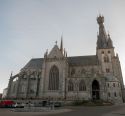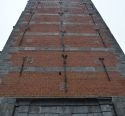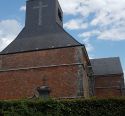Church | 1202 | Romanesque, Gothic | Catholic Church


Map
Opening hours
01 March - 31 October
Mon -
Tue -
Wed 14.00 - 17.00
Thu -
Fri 14.00 - 17.00
Sat 10.00 - 16.00
Sun 10.00 - 16.00
01 November - 28 February
Mon -
Tue -
Wed -
Thu -
Fri -
Sat 10.00 - 16.00
Sun 10.00 - 16.00
Guided tour
Religious offices
Description
Note the font and the baptismal font in blue stone, the Way of the Cross in engravings from the 19th century, the wooden Christ carved above the altar, a painting of the crowning of the Virgin, the statues of Saints Martin, Eligius and Roch, a confessional and an altarpiece of the Virgin (Louis XV), numerous tombstones, stained glass windows from the 20th century.
KIKIRPA : Photo-library online
Photos
Remarkable elements
Entrance drum
A very sober four-leaf drum (1701-1800 ?)(one leaf on each side and two juxtaposed leaves in the center). Its style is reminiscent of Louis XV (lack of symmetry, gendarme hat) but without decoration (rocaille).
Each door is divided into three superimposed, asymmetrical, curved panels. The central vertical panel is of the "chapeau de gendarme" type. The two doors at the back are of the same construction as the central double door. The two corner jambs are rounded and molded, with slight decoration at the feet and heads of the side doors.
Confessional and chronogram 1768
Made of oak, in the Louis XV style, known as the rocaille style (C curves, gadroons, flowers, fruits, shells, foliage). The reading of the bichrome chronogram allows to date the piece of furniture in 1768.
Altarpiece of the Holy Virgin
The Holy Virgin's restoration : oak niche altarpiece in the Louis XV style (rocaille style: curves, shells, palmettes and acanthus leaves). First half of the 18th century.
Statue of the Virgin : decorating the niche, this statue has replaced the original, which has disappeared. It represents the Virgin and Child. It is made of gilded polychrome wood and should have been sculpted between 1791 and 1810.
Christ on the cross and stained glass window
Christ on the cross : gothic carved wood, height: 150 cm
1501-1600: the cross
1791-1810: the Christ
Stained glass window: made between 1922 and 1948, after a drawing by Louis Buisseret, a famous Hennuyer painter
Altarpiece of St Nicolas
Carved oak, dated at the top to 1623, French Renaissance style. Above the two fluted and ringed columns, a Corinthian capital (two rows of acanthus leaves), supports an entablature topped by a niche surrounded by caryatids.
From 1627 to 1630 at least, Jean Blampain was the rector of this altar, paid for solely by the donors (the Rond family, owners of the castle at the western entrance to the village) who had themselves buried there. This altarpiece was repatriated to the main church, following the demolition of the two side chapels, which had fallen into ruin in the 19th century.
Carved blocks and mouldings along the north side
In carved wood, representing the apostles and several saints. 22 figures, three of which have disappeared. This collection (1550-1600) is rare if not unique.
Moïse : a perpendicular piece of wood, twinned and used to maintain several other pieces of a frame assembly.
Blochet : term used in carpentry to describe a piece of wood positioned horizontally and forming a strut with the foot of a crossbeam.



















